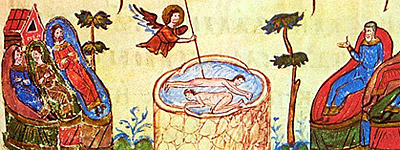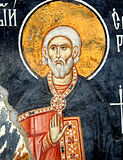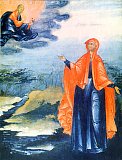

| Previous day | Next day |
| Old Style
April 24
|
Sunday |
New Style
May 7
|
| 4th Sunday of Pascha. Sunday of the Paralytic. Tone 3. | No fast.
|
![]() Righteous Tabitha of Joppa (1st c.).
Righteous Tabitha of Joppa (1st c.). ![]() Martyr Sabbas Stratelates (“the General”), of Rome, and 70 soldiers with him (272).
Martyr Sabbas Stratelates (“the General”), of Rome, and 70 soldiers with him (272). ![]() Second translation of the relics (1711) of Martyr Abraham of the Bulgars on the Volga (1230).
Second translation of the relics (1711) of Martyr Abraham of the Bulgars on the Volga (1230).
Martyr Alexander of Lyon (177). Martyrs Pasicrates, Valentine, and Julius, at Dorostolum in Moesia (228). Martyrs Eusebius, Neon, Leontius, Longinus, and others, at Nicomedia (303). St. Thomas, fool-for-Christ, of Syria (ca. 546-560). St. Elizabeth the Wonderworker, of Constantinople (6th c.-8th c.). St. Sabbas of the Kiev Caves (13th c.). St. Alexis the Hermit, of the Kiev Caves (13th c.). New Hieromartyr Branko, priest, of Veljusa, Serbia (1941).
New Martyr Theodore of Byzantium, who died at Mytilene (1795). St. Innocent, priest, on the Mount of Olives (4th c.). St. Wilfrid, bishop of York (709). St. Egbert, bishop of Iona (729). St. Xenophon, founder of Xenophontos Monastery, Mt. Athos (ca. 1018). New Martyr Doukas of Mytilene (1564). Sts. Symeon (Stefan) (1656), Elias (Iorest) (1678) and Sava (Brancovici) (1683), metropolitans of Ardeal (Transylvania), confessors against the Calvinists. St. Joseph the Confessor, bishop of Maramures (Romania) (ca. 1711). New Martyr Nicholas of Magnesia (1795). New Martyr George, in Anatolia (1796). St. Alexis Toth, priest, of Wilkes-Barre, Pennsylvania (1909).
Repose of Schemamonk Nicholas of Valaam (1947).
Thoughts for Each Day of the Year
According to the Daily Church Readings from the Word of God
By St. Theophan the Recluse

Sunday of the Paralytic. [Acts 9:32–42; John 5:1–15]
Behold, thou art made whole: sin no more, lest a worse thing come unto thee (John 5:14). Sin does not strike only the soul, but the body as well. In some cases this is exceedingly obvious; in others, although not so clearly, the truth remains that the illnesses of the body always stem from sins. A sin is committed in the soul and directly makes it sick; but since the life of the body comes from the soul, then the life coming from a sick soul is of course not healthy. The mere fact that sin brings darkness and sorrow must unfavourably act on the blood, in which lies the basis of bodily health. But when you remember that it separates man from God, the Source of life, and places man in disharmony with all laws acting in himself and in nature, then one must marvel how a sinner remains alive after sinning. This is the mercy of God, Who awaits repentance and conversion. Consequently, a sick person must rush first of all to be cleansed of sins and make peace with God in his conscience. This paves the way for the beneficial action of medicine. They say that there was one distinguished doctor who would not begin treatment until the patient had confessed and received the holy Mysteries; and the more serious the disease, the more urgently he insisted upon this.
Articles
 Martyrs Pasikrates and Valentine in Moesia, BulgariaThe Martyrs Pasikrates and Valentine came from the city of Durostorum, Silistria (now Bulgaria) and were soldiers under the governor Absolanus. |
 Venerable Thomas the Fool of SyriaSaint Thomas the Fool-for-Christ was a monk in one of the monasteries in Caesarea of Cappadocia (Asia Minor). |
 St. Elizabeth the Wonderworker of ConstantinopleSaint Elizabeth the Wonderworker was from Constantinople, and was chosen for the service of God at birth. |
 Venerable Sava the Recluse of the Kiev Far CavesSaint Sava of the Caves lived in the Near Caves of the Kiev Caves monastery during the thirteenth century. |
 Venerable Alexius the Recluse of the Kiev Far CavesSaint Alexius, Hermit of Caves, lived a life of asceticism in the Near Caves of the Kiev Caves monastery during the thirteenth century. |
 Sunday of the Paralytic |





